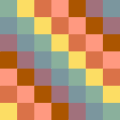Túpac Katari
Túpac Katari or Catari (also Túpaj Katari) (c. 1750–November 15, 1781), born Julián Apasa Nina, was the indigenous Aymara leader of a major insurrection in colonial-era Upper Peru (now Bolivia), laying siege to La Paz for six months. His wife Bartolina Sisa and his sister Gregoria Apaza participated in the rebellion by his side.[1] The rebellion was ultimately put down by Spanish loyalists and Katari was executed by quartering.
Túpac Katary | |
|---|---|
 Portrait in the Gallery of Latin American Patriots | |
| Born | Julián Apasa Nina c. 1750 |
| Died | November 15, 1781 (aged 30–31) |
| Nationality | Aymara |
| Other names | Catari, Túpaj Katari |
Biography


Katari was born Julián Apasa in the jurisdiction of Sicasica and later moved to the nearby town of Ayoayo. He was born a peasant and worked as a trader of coca and baize.[2]
A member of the Aymara, Apasa took the name "Tupac Katari" to honor two earlier rebel leaders: Tomás Katari, and Túpac Amaru II, executed by the Spanish in 1572. Katari's uprising was simultaneous with the Rebellion of Túpac Amaru II, whose cacique leader claimed to be a descendant of the earlier Túpac Amaru. Túpac Katari had no traditional claim to leadership similar to that of Túpac Amaru II, which may well have prompted Katari to associate himself with earlier leaders. Katari claimed authority from Túpac Amaru and proclaimed himself viceroy of the region. ("Katari" means "serpent, large snake" in Aymara; "Amaru" means the same in Quechua, the language of Tupac Amaru. "Tupac" means "brilliant, resplendent" in both languages.)[3]
He raised an army of some 40,000 and laid siege to the city of La Paz in 1781. Katari and his wife Bartolina Sisa set up court in El Alto and maintained the siege from March to June and from August to October. Sisa was a commander of the siege, and played the crucial role following Katari's capture in April. The siege was broken by the Spanish colonial troops who advanced from Lima and Buenos Aires.[4] During the siege, 20,000 people died.[5]
Katari laid siege again later in the year, this time joined by Andrés Túpac Amaru, nephew of Túpac Amaru II, but Katari lacked adequate forces to be successful.
By August 5th, Túpac Katari and his forces had besieged the city, and a few weeks later they were joined by forces led by Andrés Túpac Amaru. In mid-September, another cousin of the Inca rebel leader, Miguel Bastidas Túpac Amaru, arrived to help prosecute the siege before it was finally broken by Spanish loyalists led by Josef Reseguín on October 17, 1781. As the royalist noose tightened, Túpac Katari was captured and was executed on November 13. Diego Cristóbal Túpac Amaru was captured at Marcapata in Quispicanchis on March 15, 1782. Having no alternatives to survive, Miguel Bastidas Túpac Amaru obtained a pardon by assisting the Spanish in suppressing what was left of the rebellion. [6]
Katari had a reputation as a fierce and often violent leader. Other leaders in the rebel camps testified to his "homicides and enormous violence"; he was known not only for violence toward his enemies but also those who fought on his side, executing people for having "spoken against him, stolen his property, acted in an overweening fashion, challenged his authority, or humiliated him".[7]
On his death on 15 November 1781, Katari's final words were, according to oral tradition, "Nayawa jiwtxa nayjarusti waranqa waranqanakawa kutanipxa." This is translated from Aymara as "I die but will return tomorrow as thousand thousands".[8]
Legacy
For his effort, his betrayal, defeat, torture and brutal execution (torn by his extremities into four pieces, or Quartering), Túpac Katari is remembered as a hero by modern indigenous movements in Bolivia, who call their political philosophy Katarismo. A Bolivian guerrilla group, the Tupac Katari Guerrilla Army, also bears his name. Bolivia's first satellite in orbit was named Túpac Katari 1.
Further reading
- del Valle de Siles, María Eugenia, Historia de la rebelión Túpac Catari, 1781-1782. (1900)
- Fisher, Lillian Estelle, The Last Inca Revolt, 1780-1783. 1966.
- O'Phelan Godoy, Rebellions and Revolts in Eighteenth-Century Peru and Upper Peru. 1985.
- Paredes, M. Rigoberto, Túpac Catari: Apuntes biográficos (1897, 1973).
- Robin, Diana; Jaffe, Ira (1999). Redirecting the Gaze: Gender, Theory, and Cinema in the Third World. SUNY Press. ISBN 9780791439937.CS1 maint: ref=harv (link)
- Stern, Steve J., ed. Resistance, Rebellion, and Consciousness in the Andean Peasant World, 18th to 20th Centuries. 1987.
- Valencia Vega, Alipio, Julián Tupaj Katari, caudillo de la liberación india. 1950
References
- Kendall W. Brown, "Túpac Catari (Julián Apaza)" in Encyclopedia of Latin American History and Culture, vol. 5, p. 280. New York: Charles Scribner's Sons 1996.
- Thomson, Sinclair. (2002). We alone will rule : native Andean politics in the age of insurgency. Madison: University of Wisconsin Press. p. 183. ISBN 0-299-17790-4. OCLC 49512082.
- Thompson, Sinclair (2002). We Alone Will Rule: Native Andean Politics in the Age of Insurgency, Madison: University of Wisconsin Press, p. 190.
- Hylton, Forrest (2007). Revolutionary horizons: Popular struggle in Bolivia. London: Verso. ISBN 978-1-84467-070-3.
- "Rebellions". History Department, Duke University. 22 February 1999. Archived from the original on 31 January 2012. Retrieved 14 July 2013.
- http://migs.concordia.ca/documents/RobinsSymbolicDiscourse.doc
- Thomson, Sinclair Verfasser (2003). We alone will rule native andean politics in the age of insurgency. Univ. of Wisconsin Pr. p. 193. ISBN 0-299-17794-7. OCLC 1074951244.
- Robin & Jaffe 1999, p. 199
External links
- tupackatari.org: Bolivian indigenous activist page (in Spanish) (link broken)
- Boston Globe article on Bolivian politics, mentioning Tupac Katari.
- Great Rebellion of Peru and Upper Peru by Nicholas A. Robins